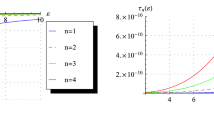Abstract
Interband and intersubband optical transitions in quantum wires are studied theoretically with allowance for scattering of carriers by both long-wavelength acoustic vibrations in a homogeneous magnetic field with the strength vector H of which is directed perpendicularly to the nanostructure axis. The features of the absorption spectra of a weak electromagnetic wave with an increase in the magnetic field are studied. In particular, it is shown that new channels of light absorption appear for interband optical transitions in the presence of a magnetic field. With an increase in the magnitude of H, absorption maximums are shifted to the region of higher frequencies; in this process, distances between the absorption bands increase. For intersubband optical transitions, frequency dependences of light absorption coefficients are calculated and analyzed with allowance for light polarization (linearly and circularly polarized light). Conditions under which processes of carrier scattering on a rough surface have a significant effect on optical characteristics of nanowires are discussed.
Similar content being viewed by others
References
E. P. Sinyavskii and N. S. Kostyukevich, Opt. Spectrosc. 114 (2), 205 (2013).
C. W. J. Beenakker and H. Van Houten, Solid State Physics. Semiconductor Heterostructures and Nanostructures, Ed. by H. Ehrenreich and D. N. Turnbull (Academic, New York, 1991), Vol. 44, p. 83.
V. A. Geiler, V. A. Margulis, and L. I. Filina, Zh. Eksp. Teor. Fiz. 113 (4), 1376 (1998).
V. A. Geiler and V. A. Margulis, Fiz. Tekh. Poluprovodn. 33 (9), 1141 (1999).
R. Kubo, J. Phys. Soc. Jap. 12 (6), 570 (1957).
M. R. Black, M. Padi, S. B. Cronin, Y.-M. Lin, O. Rabin, T. McClure, G. Dresselhaus, P. L. Hagelstein, and M. S. Dresselhaus, Appl. Phys. Lett. 77 (25), 4142 (2000).
M. R. Black, Y.-M. Lin, S. B. Cronin, O. Rabin, and M. S. Dresselhaus, Phys. Rev. B 65 (19), 195417 (2002).
A. J. Levin, M. R. Black, and M. S. Dresselhaus, Phys. Rev. B 79 (16), 165117 (2009).
H. Sakaki, T. Noda, K. Hirakawa, M. Tanaka, and T. Matsusue, Appl. Phys. Lett. 51 (23), 1934 (1987).
E. P. Sinyavskii and V. G. Solovenko, Phys. Sol. St. 56 (11), 2269 (2014).
Author information
Authors and Affiliations
Corresponding author
Additional information
Original Russian Text © E.P. Sinyavskii, E.Yu. Kanarovskii, N.S. Kostyukevich, 2015, published in Optika i Spektroskopiya, 2015, Vol. 119, No. 5, pp. 783–789.
Rights and permissions
About this article
Cite this article
Sinyavskii, E.P., Kanarovskii, E.Y. & Kostyukevich, N.S. The effect of the magnetic field on optical properties of quantum wires. Opt. Spectrosc. 119, 805–811 (2015). https://doi.org/10.1134/S0030400X15110211
Received:
Published:
Issue Date:
DOI: https://doi.org/10.1134/S0030400X15110211




